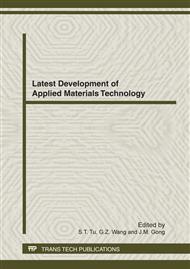[1]
Jinzhu Tan, Y.J. Chao, Min Yang, Woo-Kum Lee and J.W. Van Zee, Chemical and mechanical stability of a Silicone gasket material exposed to PEM fuel cell environment, Int. J. Hydrogen Energy 36(2) (2011) 1846-1852.
DOI: 10.1016/j.ijhydene.2009.12.048
Google Scholar
[2]
Gang Liu, Hai Liu, Yong Liu and Shiyu He, The degradation of DGEBA/DICY under 100 keV proton irradiation, Polym. Degrad. Stab. 96(4) (2011) 732-738.
DOI: 10.1016/j.polymdegradstab.2010.07.026
Google Scholar
[3]
Quanlin Zhao, Xiaogang Li and Jin Gao, Aging behavior and mechanism of ethylene-propylene-diene monomer (EPDM) rubber in fluorescent UV/condensation weathering environment, Polym. Degrad. Stab. 94(3) (2009) 339-343.
DOI: 10.1016/j.polymdegradstab.2008.12.007
Google Scholar
[4]
Kenichi Haji, Yong Zhu, Masahisa Otsubo and Tatsuya Sakoda, Studies on erosion of silicone rubber exposed to partial arc discharges, Polym. Degrad. Stab. 93(12) (2008) 2214-2221.
DOI: 10.1016/j.polymdegradstab.2008.05.025
Google Scholar
[5]
Xiaoqing Zhang, Maria Espiritu, Alex Bilyk and Lusiana Kurniawan, Morphological behaviour of poly(lactic acid) during hydrolytic degradation, Polym. Degrad. Stab. 93(10) (2008) 1964-1970.
DOI: 10.1016/j.polymdegradstab.2008.06.007
Google Scholar
[6]
Yaming Wang, Lan Liu, Yuanfang Luo and Demin Jia, Aging behavior and thermal degradation of fluoroelastomer reactive blends with poly-phenol hydroxy EPDM, Polym. Degrad. Stab. 94(3) (2009) 443-449.
DOI: 10.1016/j.polymdegradstab.2008.11.007
Google Scholar
[7]
B.H. Youn and C.S. Huh, Surface degradation of HTV silicone rubber and EPDM used for outdoor insulators under accelerated ultraviolet weathering condition, IEEE Trans. Dielect. Electr. Insul. 12(5) (2005) 1015–1024.
DOI: 10.1109/tdei.2005.1522194
Google Scholar
[8]
Susanta Mitra, Afshin Ghanbari-Siahkali, Peter Kingshott, Helle Kem Rehmeier, Hans Abildgaard and Kristoffer Almdal, Chemical degradation of crosslinked ethylene-propylene-diene rubber in an acidic environment. Part I. Effect on accelerated sulphur crosslinks, Polym. Degrad. Stab. 91 (2006) 69-80.
DOI: 10.1016/j.polymdegradstab.2005.04.032
Google Scholar
[9]
Susanta Mitra, Afshin Ghanbari-Siahkali, Peter Kingshott, Helle Kem Rehmeier, Hans Abildgaard and Kristoffer Almdal, Chemical degradation of crosslinked ethylene-propylene-diene rubber in an acidic environment. Part II. Effect of peroxide crosslinking in the presence of a coagent, Polym. Degrad. Stab. 91 (2006) 81-93.
DOI: 10.1016/j.polymdegradstab.2005.04.031
Google Scholar
[10]
Susanta Mitra, Afshin Ghanbari-Siahkali, Peter Kingshott, Kristoffer Almdal, Helle Kem Rehmeier, Anders G. Christensen, Chemical degradation of fluoroelastomer in an alkaline environment, Polym. Degrad. Stab. 83 (2004) 195–206.
DOI: 10.1016/s0141-3910(03)00235-0
Google Scholar
[11]
D. Graiver, K.W. Farminer, R. Narayan, A review of the fate and effects of silicones in the environment, J. Polym. Environ. 11(4) (2003) 129–136.
Google Scholar
[12]
Y.T. Hsu, K.S. Chang-Liao T.K. Wang and C.T. Kuo, Monitoring the moisture-related degradation of ethylene propylene rubber cable by electrical and SEM methods, Polym. Degrad. Stab. 91(10) (2006) 2357-2364.
DOI: 10.1016/j.polymdegradstab.2006.04.003
Google Scholar
[13]
Cheng Chen,and Thomas F. Fuller, The effect of humidity on the degradation of Nafion® membrane, Polym. Degrad. Stab. 94(9) (2009) 1436-1447.
Google Scholar
[14]
Tsutomu Nakamura, Oraphin Chaikumpollert, Yoshimasa Yamamoto, Yoshito Ohtake and Seiichi Kawahara, Degradation of EPDM seal used for water supplying system, Polym. Degrad. Stab. 96(7) (2011) 1236-1241.
DOI: 10.1016/j.polymdegradstab.2011.04.007
Google Scholar
[15]
J. Tan, Y.J. Chao, W.K. Lee, C.S. Smith, J.W. Van Zee and C.T. Williams, Degradation of gasket materials in a simulated fuel cell environment, Proceedings of the 4th international conference on fuel cell science, Engineering and Technology, June 19–21 Irvine, CA (2006).
DOI: 10.1115/fuelcell2006-97124
Google Scholar
[16]
J. Tan, Y.J. Chao, J.W. Van Zee and W.K. Lee, Degradation of elastomeric gasket materials in PEM fuel cells, Mater. Sci. Eng. A 445-446 (2007) 669-675.
DOI: 10.1016/j.msea.2006.09.098
Google Scholar
[17]
J. Tan, Y.J. Chao, M. Yang, C.T. Williams and J.W. Van Zee, Degradation characteristics of elastomeric gasket materials in a simulated PEM fuel cell environment, J. Mater. Eng. Performance 17 (2008) 785–792.
DOI: 10.1007/s11665-008-9233-5
Google Scholar
[18]
J. Tan, Y.J. Chao, J.W. Van Zee and W.K. Lee, Assessment of mechanical properties of fluoroelastomer and EPDM in a simulated PEM fuel cell environment by microindentation test, Mater. Sci. Eng. A 496 (2008) 464–470.
DOI: 10.1016/j.msea.2008.05.052
Google Scholar
[19]
J. Tan, Y.J. Chao, H. Wang, J. Gong and J.W. Van Zee, Chemical and mechanical stability of EPDM in a PEM fuel cell environment, Polym. Degrad. Stab. 94 (2009) 2072–2078.
DOI: 10.1016/j.polymdegradstab.2009.07.009
Google Scholar
[20]
J. Tan, Y.J. Chao, X. Li, J.W. Van Zee and W.K. Lee, Microindentation Test for Assessing the Mechanical Properties of Silicone Rubber Exposed to a Simulated Polymer Electrolyte Membrane Fuel Cell Environment, J. Fuel Cell Sci. Technol. 6 (2009) 041017(1–9).
DOI: 10.1115/1.3008030
Google Scholar
[21]
D. Lin-Vien, N.B. Colthup, W.G. Fateley, J.G. Grasselli, The Handbook of Infrared and Raman Characteristic Frequencies of Organic Molecules, Academic Press, Boston, 1991.
DOI: 10.1016/b978-0-08-057116-4.50005-5
Google Scholar
[22]
N.Yoshimura, S.Kumagai, S. Nishimura, Electrical and environmental aging of silicone rubber used in outdoor insulation, IEEE Trans. Dielect. Elect. Insul. 6(5) (1999) 632–650.
DOI: 10.1109/94.798120
Google Scholar
[23]
F.Delor-Jestin, N.S. Tomer, R.P. Singh, J. Lacoste, characterization of polydimethylsilsiloxane rubber upon photochemical, thermal, salt-fog ageings and exposure to acid vapours, E-Polymer 5 (2006) 1–13.
DOI: 10.1515/epoly.2006.6.1.172
Google Scholar
[24]
W. Noll, Chemistry and Technology of Silicone, Academic Press, Boston, 1968.
Google Scholar


